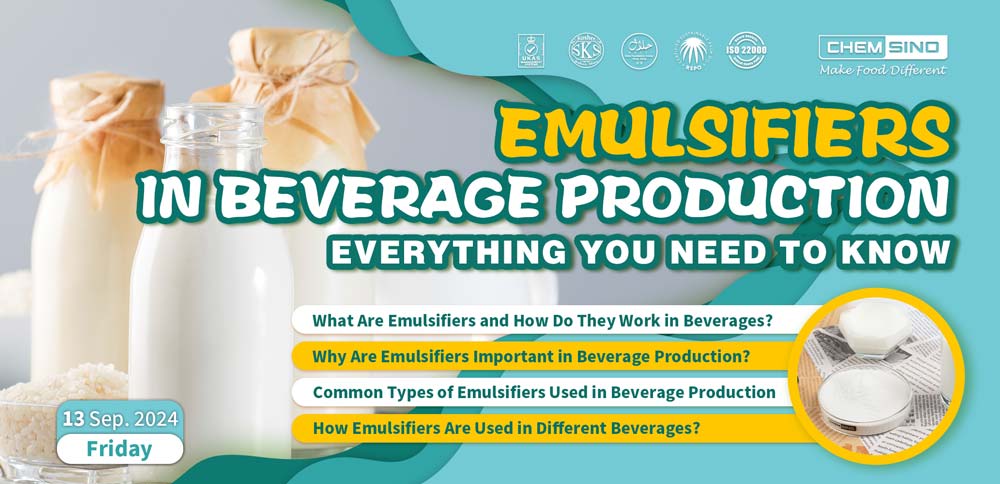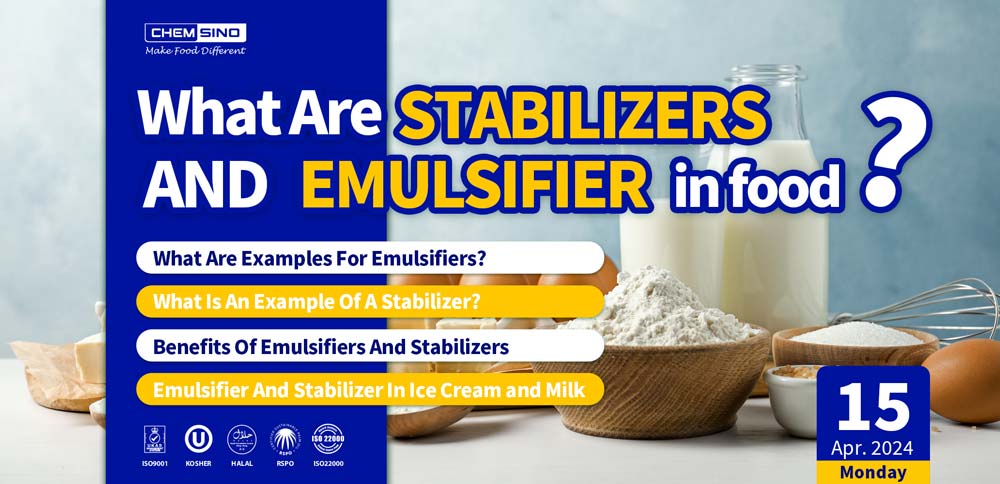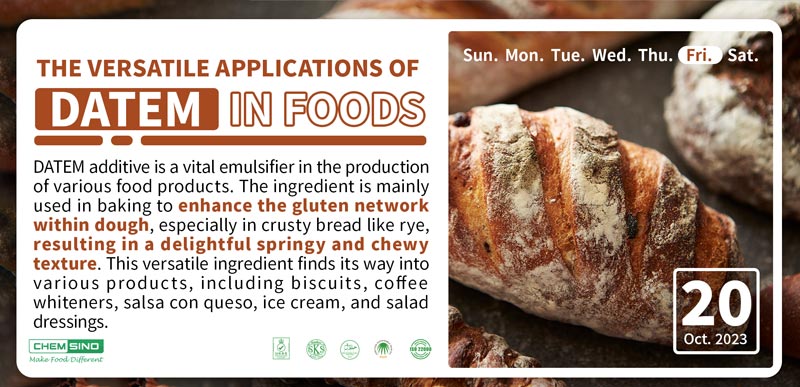As ice creams move down the scale from premium, getting lower in fat and incorporating more air, ingredients are added to make up for the loss of creamy texture, rich “mouth feel”, and to help keep all of the extra air whipped up.
Emulsifiers such as the monoglyceride glycerol monostearate and related diglycerides help to keep the milk fat in suspension and limit the growth of ice crystals. Other emulsifiers such as lecithin and polysorbate 80 perform similar functions. Emulsifiers have a significant effect on making the fat globules stick together in chains, rather than flowing together in larger globules, or staying separated as tiny ones. This adds to the structure of the ice cream and affects the texture and the ability to incorporate air into the mixture.
Gums such as guar gum, locust bean gum, xanthan gum, carrageenan, and methylcellulose help to prevent ice crystals from forming during freezing and re-freezing after a trip from the grocery store. They also have a “mouth feel” similar to milk fat, so the milk fat is not missed as much in low-fat ice creams. Like emulsifiers, they also aid in keeping the air whipped into the mix. Gums keep the ice cream from becoming grainy due to crystals forming from either ice or lactose.
Some ice creams contain sodium citrate to decrease the tendency of fat globules to coalesce, and to decrease protein aggregation. This results in a “wetter” ice cream. The citrates and phosphates are both used for this effect. Calcium and magnesium salts have the opposite effect, making a “dryer” ice cream.
Below is a list of ice cream additives with brief description (negative side focused) :-
The following is a list of common ingredients found in most commercial ice cream products. Prepare to be appalled by the apparent lack of concern for the welfare of the consumers. Prepare to be enraged that the FDA has given approval for these ingredients to be put in our food in the interest of enriching the food processing corporations.
Butyraldehyde is a derivative of butane, used in manufacturing plasticizers, alcohols, solvents and polymers. It has an almond like the smell and is used to make flavours.
Amyl acetate, more often called banana oil, is used as a flavouring agent. It is also a paint and lacquer solvent and is used in the preparation of penicillin.
Diethyl glycol is used in the production of polyester resins and plasticizers, and is a paint solvent. In ice cream, it’s used as a cheap substitute for eggs to thicken the product. Three years ago it was mistakenly used in paracetamol (acetaminophen) syrup and caused the deaths of 25 children in Bangladesh. Five years ago, it was found in discount toothpaste made in China and pulled from store shelves in Miami, Port of Los Angeles & Puerto Rico. Health officials called it a sweet syrupy poison and warned it was toxic to children and people with kidney or liver disease. “Counterfeiters” have found it profitable to substitute diethylene glycol for its chemical cousin glycerin because it is cheaper. The FDA said the substance in ANY amount is not suitable for use in toothpaste. ( I find it interesting that it’s not suitable for use in a product that is spit out, but ok for a food that is intentionally ingested)
Aldehyde C-17 is an inflammable liquid used in dyes, plastics, rubber and as a food flavoring. I did several searches looking for this specific aldehyde but couldn’t find it anywhere, though there is much online regarding aldehydes in general, as well as specific types. For me…something that can be doubled as a food flavouring as well as in the manufacture of plastics and rubber, isn’t something I think I want to eat.
Piperonal is used in place of vanilla as a cheap substitute though, interestingly, it is a natural substance that comes from the vanilla bean. It is listed in the National Library of Medicine HSDB Database as “moderately toxic” and a “human skin irritant”. Another use for it? To kill lice. I can’t wonder at the term “moderately toxic”. Does that mean it will only cause a small amount of cancer? Or only make people a little sick? Or maybe it means we won’t die quickly but at a more “moderate” pace.
Ethyl Acetate is a solvent in coatings and inks and is used for the extraction of fatty materials during food processing. It’s also used to create a pineapple flavour. The vapour is known to cause chronic lung, liver, and heart damage. The MSDS (Material Safety Data Sheet) claims toxicity if ingested in quantity but warns that formaldehyde toxicity increases with ethyl acetate. That might be an interesting twist in “diet” ice creams that use aspartame, as aspartame is a chemical which transforms into formaldehyde in the body. Or even better…have an ice cream float with diet soda which contains formaldehyde caused by aspartame! Woo Hoo!!! Cancer Sundae!
Monoglycerides, Diglycerides, & Triglycerides – all three substances are composed of fatty acids, and all may contain trans fats when those fatty acids are subjected to high heat processing. The industry only has to report trans fat content from triglycerides (not mono or di) even though trans fats are inevitably formed when mono and di are manufactured. {industry is playing with serving sizes in order to keep trans fats under the ½ gram per “serving” allowance so as not to have to report them. Under ½ equals zero for labeling.}
Disodium phospate – the MSDS is rather useless. Apparently not much is known about the chemical other than it’s slightly hazardous in case of skin and or eye contact, and in case of ingestion and inhalation. Carcinogenic Effects: not available Mutagenic Effects: not available Teratogenic Effects: not available Developmental Toxicity: not available. I guess not knowing is the same as being safe when it comes to food processing.
Benzyl acetate is used in soaps, detergents, incense, oils, lacquers, polishes, printing inks and as a solvent in plastics and resins. It is also used in food flavors. It is known to be carcinogenic in rodents, causing tumors in lungs, liver and gastrointestinal organs, though it’s claimed that there’s only a 0.1% probable chance of such in humans. That’s an interesting claim as there is very little reproductive data or long term studies to determine dangers.
Monostearates are considered of low toxicity but
toxic nonetheless.
Propylene glycol – The ATSDR lists the skin, kidneys, urinary, and respiratory systems as being affected by the chemical. It’s a synthetic liquid that absorbs water and is used in foods to absorb extra water and maintain moisture. It’s a solvent for food colors and flavors, and in plastics and paint.








